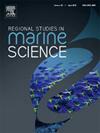Annual assessment of mangrove defoliation by Hyblaea puera (Cramer, 1777) around Thane Creek, India using field observations and Sentinel-2 imagery from 2018 to 2022
IF 2.1
4区 环境科学与生态学
Q3 ECOLOGY
引用次数: 0
Abstract
Mangroves are salt-tolerant trees thriving in coastal and brackish waters, adapting to harsh conditions with features like aerial roots and salt filtering. Out of 64 global mangrove species, 11 are endangered. In Maharashtra, mangroves are concentrated around Mumbai, with an estimated 54.5 square kilometers in Thane Creek, where Avicennia marina shows signs of infestation. This current research used Sentinel-2 data from 2018 to 2022 to assess defoliation caused by Hyblaea puera, the teak defoliator. Ground-truth observations from 2020 to 2022 confirmed the extent of defoliation and identified varying infestation levels categorized as very highly infested, highly infested, moderately infested, low infested, very low infested, and uninfested. NDVI analysis examined these levels in relation to meteorological factors such as rainfall, temperature, humidity, and wind speed. The analysis revealed an extended peak infestation both spatially and temporally, along with severe defoliation during the study period. Six categorical infestation hotspots were identified and compared with meteorological parameters, revealing that Hyblaea outbreaks were more common during low wind speeds and moderate temperatures, with peak infestations occurring after heavy rainfall and under moderate relative humidity. The study suggests further research to explore outbreak causes, insect preferences for specific mangrove species, and the broader implications of defoliation.
利用2018年至2022年的野外观测和Sentinel-2图像,对印度Thane Creek附近Hyblaea puera (Cramer, 1777)红树林落叶的年度评估
红树林是一种耐盐的树木,生长在沿海和微咸水域,通过气生根和盐过滤等特征适应恶劣的环境。在全球64种红树林中,有11种濒临灭绝。在马哈拉施特拉邦,红树林集中在孟买周围,在塔纳河估计有54.5平方公里,阿维森尼亚码头显示出虫害的迹象。目前的研究使用了2018年至2022年的Sentinel-2数据来评估柚木落叶剂Hyblaea puera造成的落叶。从2020年到2022年的实地观察证实了落叶的程度,并确定了不同的虫害程度,分为高度侵染、高度侵染、中度侵染、低侵染、极低侵染和未侵染。NDVI分析考察了这些水平与气象因素(如降雨、温度、湿度和风速)的关系。分析表明,在研究期间,侵染高峰在空间和时间上都延长了,并且出现了严重的落叶。通过与气象参数的比较,确定了6个不同类型的蝗灾热点,发现低风速、中等温度条件下蝗灾多发,强降雨后、中等相对湿度条件下蝗灾多发。该研究建议进一步研究,以探索爆发的原因,昆虫对特定红树林物种的偏好,以及落叶的更广泛影响。
本文章由计算机程序翻译,如有差异,请以英文原文为准。
求助全文
约1分钟内获得全文
求助全文
来源期刊

Regional Studies in Marine Science
Agricultural and Biological Sciences-Ecology, Evolution, Behavior and Systematics
CiteScore
3.90
自引率
4.80%
发文量
336
审稿时长
69 days
期刊介绍:
REGIONAL STUDIES IN MARINE SCIENCE will publish scientifically sound papers on regional aspects of maritime and marine resources in estuaries, coastal zones, continental shelf, the seas and oceans.
 求助内容:
求助内容: 应助结果提醒方式:
应助结果提醒方式:


